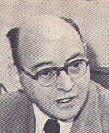Mystery Books
Mystery Movies
Mystery Authors
Ellery Queen biography
Pseudonym for Frederic Dannay and Manfred Bennington Lee (Their original names were Daniel Nathan and Manford Lepofski but they changed them as young men). They were cousins and were educated together at Brooklyn Boys High School. In 1929 they created 'Ellery Queen', a writer of crime stories featuring a detective with the name 'Ellery Queen' (quite confusing). They also wrote four novels about a detective named Drury Lane under the pseudonym 'Barnaby Ross'. They allowed the Ellery Queen name to be used as a house name for a number of novels written by other authors.
Ellery Queen is a unique fictional detective. Created by cousins Frederic Dannay and Manfred Lee as an entry in a writing contest, he is regarded by many as the definitive American whodunit celebrity, rivaling Nero Wolfe as the logical successor to the Master, Sherlock Holmes.
The cousins wrote dozens of books, and possibly hundreds of radio scripts, about the author and amatuer sleuth who shared an apartment with his Dad, Inspector Richard Queen of the New York Police Homicide squad. On stage, in the movies, and on television, the EQ legacy was continued, though not always in a manner faithful to the authors' original conceptions.
The Queen novels are examples of the classic "fair play", whodunit mystery, particularly during what became known as the "Golden Age" of the mystery novel. All the clues were made available to the reader in the same way they are to the detective, and so the reader has a fair chance too solve the mystery by himself. Mystery writer John Dickson Carr termed it "the grandest game in the world." Other characteristics of the early Queen novels were the intricately plotted clues and solutions. In The Greek Coffin Mystery (1932), multiple solutions to the mystery are proposed. The EQ "false solution, then the true" would become a hallmark of the mystery novels of the Golden Age. Another stylistic element in many early books (notably The Dutch Shoe Mystery, The French Powder Mystery and especially Halfway House) is Ellery's creation of a list of attributes of the murderer (the murderer is male, the murderer smokes a pipe, etc.). Then, by comparing each suspect to these attributes, he reduces the list of suspects to a single name, often an unlikely one.
By 1938, with Ellery making the move to Hollywood to try his hand at scriptwriting, both his character and the character of the novels began to change. Romance was introduced, the solutions began to involve psychological elements as well, and the "Challenge" vanished from the pages. The novels also moved from mere puzzles to more introspective themes. Ten Days' Wonder (1948), set in the New England town of Wrightsville (a backdrop for several Queen novels during the 1940s), even showed the limitations of Ellery's methods of detection. The 1950s and 1960s showed more experimental work.
Information source: wikipedia